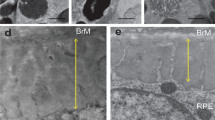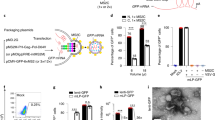Abstract
Activation of the alternative pathway of the complement system has been implicated in the pathogenesis of age-related macular degeneration. Membrane attack complex (MAC) has been identified mainly on the Bruch's membrane and drusen underlying the retinal pigment epithelium (RPE). Membrane cofactor protein (CD46) preferentially regulates the alternative pathway of complement. The aim of this study was to evaluate the potential of increasing CD46 expression on RPE cells using an adenovirus as a gene therapy approach to reduce alternative pathway-mediated damage to RPE cells. We generated a recombinant adenovirus vector expressing human CD46 (hCD46) and delivered the vector to murine hepatocytes and RPE cells in vitro. After incubation in human serum in conditions in which the classical pathway of complement was blocked, we measured alternative pathway-mediated damage of these cells by quantifying lysis and MAC formation. Adenovirus expressing hCD46 was delivered to the subretinal space of adult mice, and 1 week later, ocular flat mounts were challenged with human serum and the levels of complement-mediated damage was quantified. Adenovirus-mediated delivery of hCD46 localizes to the basal and lateral surfaces of RPE cells where it offers protection from alternative pathway-mediated damage, but not classical, allowing the classical pathway to function unhindered.
This is a preview of subscription content, access via your institution
Access options
Subscribe to this journal
Receive 12 print issues and online access
$259.00 per year
only $21.58 per issue
Buy this article
- Purchase on Springer Link
- Instant access to full article PDF
Prices may be subject to local taxes which are calculated during checkout






Similar content being viewed by others
References
Chevez-Barrios P, Chintagumpala M, Mieler W, Paysse E, Boniuk M, Kozinetz C et al. Response of retinoblastoma with vitreous tumor seeding to adenovirus-mediated delivery of thymidine kinase followed by ganciclovir. J Clin Oncol 2005; 23: 7927–7935.
Campochiaro PA, Nguyen QD, Shah SM, Klein ML, Holz E, Frank RN et al. Adenoviral vector-delivered pigment epithelium-derived factor for neovascular age-related macular degeneration: results of a phase I clinical trial. Hum Gene Theropy 2006; 17: 167–176.
Sweigard JH, Cashman SM, Kumar-Singh R . Adenovirus vectors targeting distinct cell types in the retina. Invest Ophthalmol Vis Sci 2010; 51: 2219–2228.
Lamartina S, Cimino M, Roscilli G, Dammassa E, Lazzaro D, Rota R et al. Helper-dependent adenovirus for the gene therapy of proliferative retinopathies: stable gene transfer, regulated gene expression and therapeutic efficacy. J Gene Med 2007; 9: 862–874.
Kim IH, Józkowicz A, Piedra PA, Oka K, Chan L . Lifetime correction of genetic deficiency in mice with a single injection of helper-dependent adenoviral vector. Proc Natl Acad Sci USA 2001; 98: 13282–13287.
Parks RJ, Chen L, Anton M, Sankar U, Rudnicki MA, Graham FL . A helper-dependent adenovirus vector system: removal of helper virus by Cre-mediated excision of the viral packaging signal. Proc Natl Acad Sci USA 1996; 93: 13565–13570.
Kumar-Singh R, Yamashita CK, Tran K, Farber DB . Construction of encapsidated (gutted) adenovirus minichromosomes and their application to rescue of photoreceptor degeneration. Methods Enzymol 2000; 316: 724–743.
Klein R, Klein BE, Knudtson MD, Meuer SM, Swift M, Gangnon RE . Fifteen-year cumulative incidence of age-related macular degeneration: the Beaver Dam Eye Study. Ophthalmology 2007; 114: 253–262.
van Leeuwen R, Klaver CC, Vingerling JR, Hofman A, de Jong PT . Epidemiology of age-related maculopathy: a review. Eur J Epidemiol 2003; 18: 845–854.
Ozkiris A . Anti-VEGF agents for age-related macular degeneration. Expert Opin Ther Pat 2010; 20: 103–118.
Hageman GS, Luthert PJ, Victor Chong NH, Johnson LV, Anderson DH, Mullins RF . An integrated hypothesis that considers drusen as biomarkers of immune-mediated processes at the RPE-Bruch's membrane interface in aging and age-related macular degeneration. Prog Retin Eye Res 2001; 20: 705–732.
Johnson LV, Leitner WP, Staples MK, Anderson DH . Complement activation and inflammatory processes in Drusen formation and age related macular degeneration. Exp Eye Res 2001; 73: 887–896.
Anderson DH, Mullins RF, Hageman GS, Johnson LV . A role for local inflammation in the formation of drusen in the aging eye. Am J Ophthalmol 2002; 134: 411–431.
Reynolds R, Hartnett ME, Atkinson JP, Giclas PC, Rosner B, Seddon JM . Plasma complement components and activation fragments: associations with age-related macular degeneration genotypes and phenotypes. Invest Ophthalmol Vis Sci 2009; 50: 5818–5827.
Barilla-LaBarca ML, Liszewski MK, Lambris JD, Hourcade D, Atkinson JP . Role of membrane cofactor protein (CD46) in regulation of C4b and C3b deposited on cells. J Immunol 2002; 168: 6298–6304.
Kavanagh D, Richards A, Atkinson J . Complement regulatory genes and hemolytic uremic syndromes. Annu Rev Med 2008; 59: 293–309.
Vogt SD, Barnum SR, Curcio CA, Read RW . Distribution of complement anaphylatoxin receptors and membrane-bound regulators in normal human retina. Exp Eye Res 2006; 83: 834–840.
Ramo K, Cashman SM, Kumar-Singh R . Evaluation of adenovirus-delivered human CD59 as a potential therapy for AMD in a model of human membrane attack complex formation on murine RPE. Invest Ophthalmol Vis Sci 2008; 49: 4126–4136.
Post TW, Liszewski MK, Adams EM, Tedja I, Miller EA, Atkinson JP . Membrane cofactor protein of the complement system: alternative splicing of serine/threonine/proline-rich exons and cytoplasmic tails produces multiple isoforms that correlate with protein phenotype. J Exp Med 1991; 174: 93–102.
McNearney T, Ballard L, Seya T, Atkinson JP . Membrane cofactor protein of complement is present on human fibroblast, epithelial, and endothelial cells. J Clin Invest 1989; 84: 538–545.
Edwards AO, Ritter III R, Abel KJ, Manning A, Panhuysen C, Farrer LA . Complement factor H polymorphism and age-related macular degeneration. Science 2005; 308: 421–424.
Gao LJ, Guo SY, Cai YQ, Gu PQ, Su YJ, Gong H et al. Cooperation of decay-accelerating factor and membrane cofactor protein in regulating survival of human cervical cancer cells. BMC Cancer 2009; 9: 384.
Brodbeck WG, Mold C, Atkinson JP, Medof ME . Cooperation between decay-accelerating factor and membrane cofactor protein in protecting cells from autologous complement attack. J Immunol 2000; 165: 3999–4006.
Vogt SD, Curcio CA, Wang L, Li CM, McGwin Jr G, Medeiros NE et al. Altered retinal pigment epithelium morphology is associated with decreased expression of complement regulatory protein CD46 and ion transporter MCT3 in geographic atrophy of age-related maculopathy. Invest Ophthalmol Vis Sci 2009; 50: E-Abstract 4180.
Richards A, Kemp EJ, Liszewski MK, Goodship JA, Lampe AK, Decorte R et al. Mutations in human complement regulator, membrane cofactor protein (CD46), predispose to development of familial hemolytic uremic syndrome. Proc Natl Acad Sci USA 2003; 100: 12966–12971.
Caprioli J, Noris M, Brioschi S, Pianetti G, Castelletti F, Bettinaglio P et al. Genetics of HUS: the impact of MCP, CFH, and IF mutations on clinical presentation, response to treatment, and outcome. Blood 2006; 108: 1267–1279.
Kavanagh D, Goodship TH . Membrane cofactor protein and factor I: mutations and transplantation. Semin Thromb Hemost 2006; 32: 155–159.
Fallaux FJ, Kranenburg O, Cramer SJ, Houweling A, Van Ormondt H, Hoeben RC et al. Characterization of 911: a new helper cell line for the titration and propagation of early region 1-deleted adenoviral vectors. Hum Gene Theropy 1996; 7: 215–222.
He TC, Zhou S, da Costa LT, Yu J, Kinzler KW, Vogelstein B . A simplified system for generating recombinant adenoviruses. Proc Natl Acad Sci USA 1998; 95: 2509–2514.
Cashman SM, Morris DJ, Kumar-Singh R . Adenovirus type 5 pseudotyped with adenovirus type 37 fiber uses sialic acid as a cellular receptor. Virology 2004; 324: 129–139.
Acknowledgements
This study was supported by grants to RK-S from The Ellison Foundation, The Virginia B Smith Trust and grants to the Department of Ophthalmology at Tufts University from the Lions Eye Foundation and Research to Prevent Blindness.
Author information
Authors and Affiliations
Corresponding author
Ethics declarations
Competing interests
The authors declare no conflict of interest.
Rights and permissions
About this article
Cite this article
Sweigard, J., Cashman, S. & Kumar-Singh, R. Adenovirus-mediated delivery of CD46 attenuates the alternative complement pathway on RPE: implications for age-related macular degeneration. Gene Ther 18, 613–621 (2011). https://doi.org/10.1038/gt.2011.6
Received:
Revised:
Accepted:
Published:
Issue Date:
DOI: https://doi.org/10.1038/gt.2011.6



